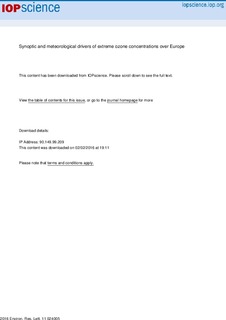| dc.contributor.author | Otero, Noelia | |
| dc.contributor.author | Sillmann, Jana | |
| dc.contributor.author | Schnell, Jordan | |
| dc.contributor.author | Rust, Henning W. | |
| dc.contributor.author | Butler, Tim | |
| dc.date.accessioned | 2019-06-06T12:20:46Z | |
| dc.date.available | 2019-06-06T12:20:46Z | |
| dc.date.created | 2016-02-03T15:18:57Z | |
| dc.date.issued | 2016 | |
| dc.identifier.issn | 1748-9326 | |
| dc.identifier.uri | http://hdl.handle.net/11250/2600175 | |
| dc.description.abstract | The present work assesses the relationship between local and synoptic meteorological conditions and surface ozone concentration over Europe in spring and summer months, during the period 1998–2012 using a new interpolated data set of observed surface ozone concentrations over the European domain. Along with local meteorological conditions, the influence of large-scale atmospheric circulation on surface ozone is addressed through a set of airflow indices computed with a novel implementation of a grid-by-grid weather type classification across Europe. Drivers of surface ozone over the full distribution of maximum daily 8 h average values are investigated, along with drivers of the extreme high percentiles and exceedances or air quality guideline thresholds. Three different regression techniques are applied: multiple linear regression to assess the drivers of maximum daily ozone, logistic regression to assess the probability of threshold exceedances and quantile regression to estimate the meteorological influence on extreme values, as represented by the 95th percentile. The relative importance of the input parameters (predictors) is assessed by a backward stepwise regression procedure that allows the identification of the most important predictors in each model. Spatial patterns of model performance exhibit distinct variations between regions. The inclusion of the ozone persistence is particularly relevant over southern Europe. In general, the best model performance is found over central Europe, where the maximum temperature plays an important role as a driver of maximum daily ozone as well as its extreme values, especially during warmer months. | nb_NO |
| dc.language.iso | eng | nb_NO |
| dc.relation.uri | http://iopscience.iop.org/article/10.1088/1748-9326/11/2/024005/pdf | |
| dc.title | Synoptic and meteorological drivers of extreme ozone concentrations over Europe | nb_NO |
| dc.type | Journal article | nb_NO |
| dc.type | Peer reviewed | nb_NO |
| dc.description.version | publishedVersion | nb_NO |
| dc.source.volume | 11 | nb_NO |
| dc.source.journal | Environmental Research Letters | nb_NO |
| dc.source.issue | 2 | nb_NO |
| dc.identifier.doi | 10.1088/1748-9326/11/2/024005 | |
| dc.identifier.cristin | 1331666 | |
| cristin.unitcode | 7475,0,0,0 | |
| cristin.unitname | CICERO Senter for klimaforskning | |
| cristin.ispublished | true | |
| cristin.fulltext | original | |
| cristin.qualitycode | 1 | |
